Difference between revisions of "Special Thin Field Camera"
(fixed reference coding) |
Hanskerensky (talk | contribs) (Added Category year of introduction) |
||
| (4 intermediate revisions by 3 users not shown) | |||
| Line 3: | Line 3: | ||
| image= http://farm2.static.flickr.com/1165/5113536609_1bcaa8d8f0.jpg | | image= http://farm2.static.flickr.com/1165/5113536609_1bcaa8d8f0.jpg | ||
| image_align=right | | image_align=right | ||
| − | | image_text= | + | | image_text= Special Thin Field Camera |
| + | |image_by=Dirk HR Spennemann | ||
| image_rights=with permission | | image_rights=with permission | ||
}} | }} | ||
| − | The Special Thin Field Camera (特別製薄形携帯用暗函) was introduced in 1894 a double-extension field camera.<ref name="Studio"> [http://www2f.biglobe.ne.jp/~ter-1212/sakura/ | + | The '''Special Thin Field Camera''' (特別製薄形携帯用暗函) was introduced in 1894 as a double-extension field camera.<ref name="Studio"> [http://www2f.biglobe.ne.jp/~ter-1212/sakura/camera.htm formerly published Rokuoh-Sha history pages]. </ref> While the camera has some similarity with the field cameras produced by Rokuoh-sha for the Japanese Navy in the late 1920s and 1930s, all of these Navy cameras use Hexar Series I lenses, and the design of the front standard is very different. The camera shown above has clear design similarities with an [[Asanuma]]. This is not surprising, however, if we consider that the artisan Tōjō Kamejirō (東条亀次郎), who had made cameras for Asanuma, from 1890 (also?) worked for Konishi Honten. |
| − | The [[Rokuoh-sha]] History Website<ref>http://www2f.biglobe.ne.jp/~ter-1212/sakura/ | + | The formerly published [[Rokuoh-sha]] History Website<ref>[http://www2f.biglobe.ne.jp/~ter-1212/sakura/camera.htm Rokuoh-Sha Camera]</ref> shows this camera as the Special Thin Portable Camera (特別製薄形携帯用暗函) introduced in Meiji 27 (1894). Reading the chronology at the site, it seems the camera was made by artisan subcontractors, most likely by Tōjō Kamejirō (東条亀次郎) for the woodwork and by Takashi Korudairō (黒田宗次郎) for the metal parts. Early Konishi cameras were produced by artisan subcontractors, such as Hasegawa Toshinosuke (長谷川利之助) and Tōjō Kamejirō (東条亀次郎). The company (Honten Konishi Rokuemon, 本店小西六右衞門) founded a manufacturing branch called [[Rokuoh-sha]] (六桜社) in 1902. The factory of Hasegawa Toshinosuke became the wood workshop of Rokuoh-sha in 1906. Most of the camera production was still assumed by other subcontractors, many of which were merged into Rokuoh-sha in 1919. |
It is at present unclear how long the camera model was in production. | It is at present unclear how long the camera model was in production. | ||
| Line 24: | Line 25: | ||
|| [http://www.flickr.com/photos/heritagefutures/5114115366/in/pool-camerawiki http://farm2.static.flickr.com/1200/5114115366_fde2fc6862_m.jpg] | || [http://www.flickr.com/photos/heritagefutures/5114115366/in/pool-camerawiki http://farm2.static.flickr.com/1200/5114115366_fde2fc6862_m.jpg] | ||
|- | |- | ||
| − | | colspan=4 | Konishi Special Thin Field Camera (特別製薄形携帯用暗函) (1894) <small> Images by Dirk HR Spennemann {{with permission}}''</small> | + | | colspan=4 | Konishi Special Thin Field Camera (特別製薄形携帯用暗函) (1894) <small> Images by {{image author|Dirk HR Spennemann}} {{with permission}}''</small> |
|} | |} | ||
</center> | </center> | ||
| Line 30: | Line 31: | ||
== Notes == | == Notes == | ||
<references /> | <references /> | ||
| + | |||
| + | [[Category:S]] | ||
| + | [[Category:Japan]] | ||
| + | [[Category:1890-1899]] | ||
Latest revision as of 03:57, 2 May 2024
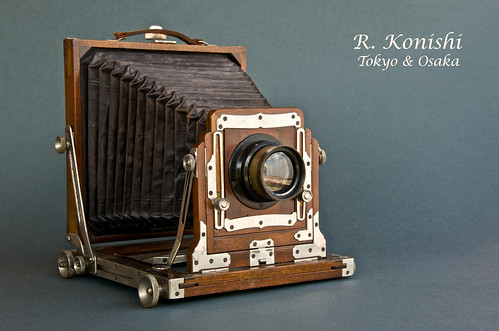
|
| Special Thin Field Camera image by Dirk HR Spennemann (Image rights) |
The Special Thin Field Camera (特別製薄形携帯用暗函) was introduced in 1894 as a double-extension field camera.[1] While the camera has some similarity with the field cameras produced by Rokuoh-sha for the Japanese Navy in the late 1920s and 1930s, all of these Navy cameras use Hexar Series I lenses, and the design of the front standard is very different. The camera shown above has clear design similarities with an Asanuma. This is not surprising, however, if we consider that the artisan Tōjō Kamejirō (東条亀次郎), who had made cameras for Asanuma, from 1890 (also?) worked for Konishi Honten. The formerly published Rokuoh-sha History Website[2] shows this camera as the Special Thin Portable Camera (特別製薄形携帯用暗函) introduced in Meiji 27 (1894). Reading the chronology at the site, it seems the camera was made by artisan subcontractors, most likely by Tōjō Kamejirō (東条亀次郎) for the woodwork and by Takashi Korudairō (黒田宗次郎) for the metal parts. Early Konishi cameras were produced by artisan subcontractors, such as Hasegawa Toshinosuke (長谷川利之助) and Tōjō Kamejirō (東条亀次郎). The company (Honten Konishi Rokuemon, 本店小西六右衞門) founded a manufacturing branch called Rokuoh-sha (六桜社) in 1902. The factory of Hasegawa Toshinosuke became the wood workshop of Rokuoh-sha in 1906. Most of the camera production was still assumed by other subcontractors, many of which were merged into Rokuoh-sha in 1919.
It is at present unclear how long the camera model was in production.
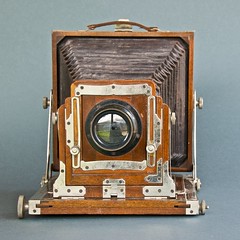
|
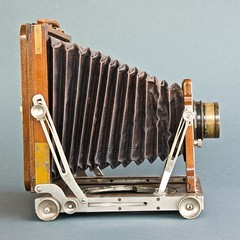
|
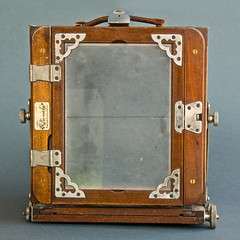
|
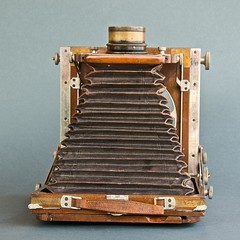
|
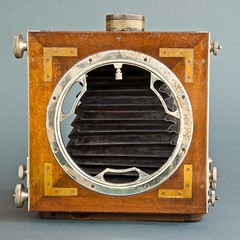
|
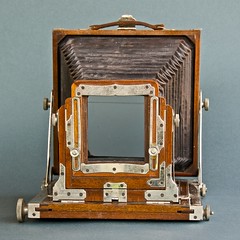
|
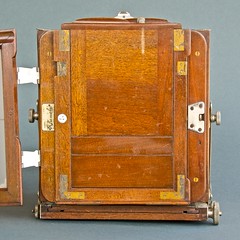
|
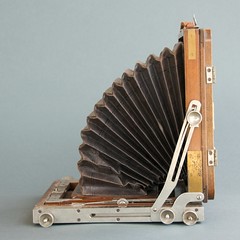
|
| Konishi Special Thin Field Camera (特別製薄形携帯用暗函) (1894) Images by Dirk HR Spennemann (Image rights) | |||